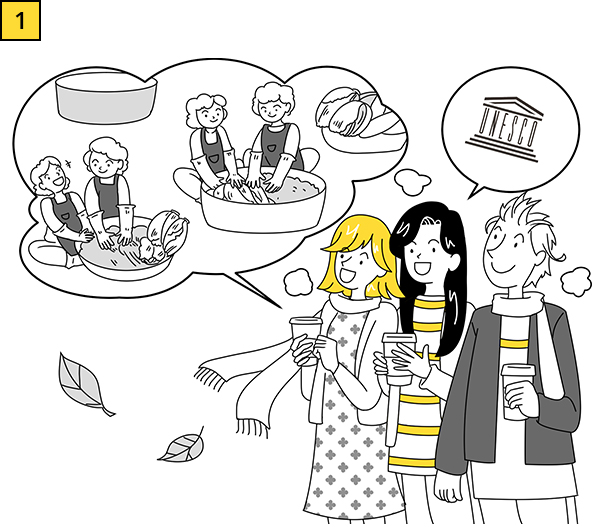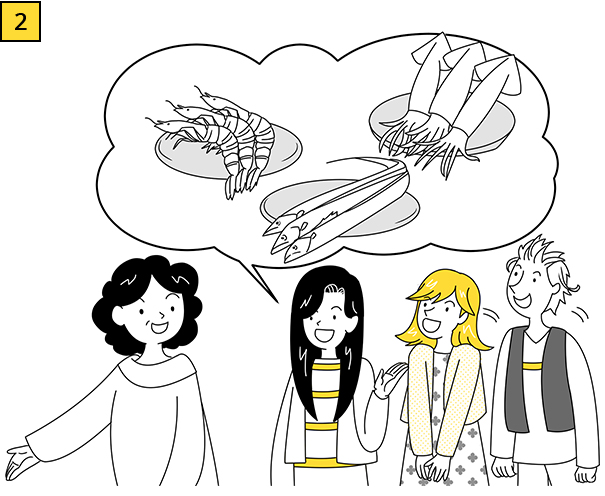December 2019

Contents










While in Korea · Written by Min Yea-Ji Illustrated by Yuhaill
Gimjang Culture
In the final episode of this series, Jessie and Pedro gather at Su-hyeon’s house to experience gimjang, the communal making and sharing of kimchi, and reflect on their lives in Korea over the past year.


Jessie: It’s almost been a year since I came to Korea to study.
Su-hyeon: Time flies. It’s already that time of year when the weather gets quite cold.
Pedro: This time of year is known as gimjangcheol in Korea, right?
Su-hyeon: That’s right. My mom, grandma and aunts used to gather for gimjang (communal making and sharing of kimchi) around this time of year. We all gathered to make kimchi when I was young, but nowadays, we often just buy it instead of making it. The trend has changed.
Pedro: I think gimjang culture is unique and interesting. It’s also interesting that Korea has refrigerators specifically to store and preserve kimchi.
Su-hyeon: Yes, so UNESCO in 2013 included gimjang on its list of Intangible Cultural Heritage.
Jessie: What’s the difference between gimjang kimchi and regular kimchi?
Pedro: In the past, Koreans made a lot of kimchi in early winter and preserved it given how hard it was to get fresh vegetables in winter. Nowadays, fresh vegetables are available year-round thanks to greenhouses, but we still have the custom of gimjang in winter. And gimjang kimchi is especially delicious (smiles).
Su-hyeon: We still do gimjang at our house. Our relatives don’t come to do it with us, though, so it’s just me and my parents. The three of us make kimchi together.
Pedro: Wow, that is so cool. Can I come over and help you make kimchi?
Jessie: Me, too. I want to see how gimjang is done.
Su-hyeon: Sure, both of you can come. Let’s gather, make kimchi and have a chit-chat to wrap up the year.
Su-hyeon: Time flies. It’s already that time of year when the weather gets quite cold.
Pedro: This time of year is known as gimjangcheol in Korea, right?
Su-hyeon: That’s right. My mom, grandma and aunts used to gather for gimjang (communal making and sharing of kimchi) around this time of year. We all gathered to make kimchi when I was young, but nowadays, we often just buy it instead of making it. The trend has changed.
Pedro: I think gimjang culture is unique and interesting. It’s also interesting that Korea has refrigerators specifically to store and preserve kimchi.
Su-hyeon: Yes, so UNESCO in 2013 included gimjang on its list of Intangible Cultural Heritage.
Jessie: What’s the difference between gimjang kimchi and regular kimchi?
Pedro: In the past, Koreans made a lot of kimchi in early winter and preserved it given how hard it was to get fresh vegetables in winter. Nowadays, fresh vegetables are available year-round thanks to greenhouses, but we still have the custom of gimjang in winter. And gimjang kimchi is especially delicious (smiles).
Su-hyeon: We still do gimjang at our house. Our relatives don’t come to do it with us, though, so it’s just me and my parents. The three of us make kimchi together.
Pedro: Wow, that is so cool. Can I come over and help you make kimchi?
Jessie: Me, too. I want to see how gimjang is done.
Su-hyeon: Sure, both of you can come. Let’s gather, make kimchi and have a chit-chat to wrap up the year.

Su-hyeon’s mother: Hello and welcome. I think our gimjang will get done quickly since we’ll have many people working on it (smiles). After we finish, please help yourselves to the newly made kimchi and bossam (boiled pork slices).
Pedro: OK. That’s exactly what we want (laughs).
Jessie: Wow, bossam?
Su-hyeon: In Korea, we often steam pork on the spot as we make kimchi and eat the pork with the newly made kimchi.
Pedro: It simply tastes awesome.
Su-hyeon’s father: Our family always puts raw oysters in our kimchi when we do gimjang. Why don’t you try it later?
Pedro: Oyster kimchi is a delicacy you can eat only with gimjang kimchi.
Su-hyeon: Gimjang kimchi differs by region. The ingredients each area puts into kimchi can vary such as raw shrimp, pollack, raw cutlassfish or raw octopus. They use less red pepper powder in the cold northern region. Baekkimchi (white kimchi made without red pepper powder) and dongchimi (radish kimchi fermented in water-based brine) are popular there. Kimchi in the Jeolla-do and Gyeongsang-do provinces often have more red pepper powder and thus their kimchi is generally spicier and saltier. Jeotgal (salted seafood) is more common in these regions, too.
Jessie: This is exciting. What shall I do first?
Su-hyeon’s mother: I put the cabbage in salt last night and prepared the spices. Let’s mix the spices with the cabbage and make kimchi.
Pedro: OK. That’s exactly what we want (laughs).
Jessie: Wow, bossam?
Su-hyeon: In Korea, we often steam pork on the spot as we make kimchi and eat the pork with the newly made kimchi.
Pedro: It simply tastes awesome.
Su-hyeon’s father: Our family always puts raw oysters in our kimchi when we do gimjang. Why don’t you try it later?
Pedro: Oyster kimchi is a delicacy you can eat only with gimjang kimchi.
Su-hyeon: Gimjang kimchi differs by region. The ingredients each area puts into kimchi can vary such as raw shrimp, pollack, raw cutlassfish or raw octopus. They use less red pepper powder in the cold northern region. Baekkimchi (white kimchi made without red pepper powder) and dongchimi (radish kimchi fermented in water-based brine) are popular there. Kimchi in the Jeolla-do and Gyeongsang-do provinces often have more red pepper powder and thus their kimchi is generally spicier and saltier. Jeotgal (salted seafood) is more common in these regions, too.
Jessie: This is exciting. What shall I do first?
Su-hyeon’s mother: I put the cabbage in salt last night and prepared the spices. Let’s mix the spices with the cabbage and make kimchi.

Su-hyeon’s mother: The bossam is ready. You should all come and try it.
Pedro: Watch and eat as I do. Put one slice of bossam and gimjang kimchi with raw oyster inside a salted cabbage, roll the cabbage and eat it.
Jessie: Wow, it’s delicious. I think eating warm white rice with kimchi will be really tasty, too.
Su-hyeon: It’s so nice to have everyone gather, make kimchi and eat together.
Jessie I’ve had so much fun hanging out with all of you over the past year.
Pedro: Me, too. I’m so lucky to have met you guys.
Su-hyeon: The While in Korea series ends here but I will continue to help you in Korea.
Pedro: Watch and eat as I do. Put one slice of bossam and gimjang kimchi with raw oyster inside a salted cabbage, roll the cabbage and eat it.
Jessie: Wow, it’s delicious. I think eating warm white rice with kimchi will be really tasty, too.
Su-hyeon: It’s so nice to have everyone gather, make kimchi and eat together.
Jessie I’ve had so much fun hanging out with all of you over the past year.
Pedro: Me, too. I’m so lucky to have met you guys.
Su-hyeon: The While in Korea series ends here but I will continue to help you in Korea.
Other Articles
















